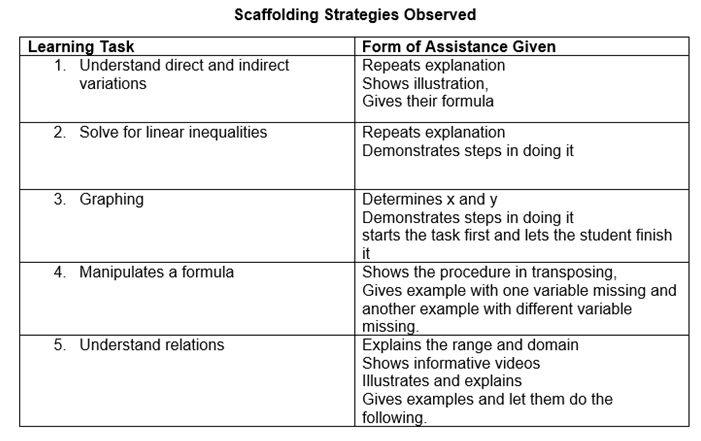Learning Experience 7: The Teacher as a Facilitator of Assisted Learning
- Irene Isip

- Nov 23, 2021
- 2 min read
Assisted learning or guided participation in the classroom requires scaffolding. This is the support a teacher provides "through clues, reminders. encouragement, breaking the problem down into steps, providing an example or anything else that allows the student to grow in independence as a learner". LE 7 challenges you to discover and identify all forms of scaffolding strategies teachers give to students for assisted learning.
Forms of Assisted Learning
1. Procedural facilitators – these help students learn a skill or procedure
2. Modelling – demonstrating or showing examples
3. Providing prompts – giving clues to give the correct answer
4. Regulating difficulty of problem or task – starting first with something easy to do or answer
5. Providing half-done examples – starting the task first and letting students finish it
Observation
I observed how my resource speaker, sir Tangonan assists learners individually or as a group while teaching. I took not how he helped them understand an idea, solve a problem, answer a question, perform a procedure, follow directions, etc. I identified the learning task to be performed by the students and the form of assistance given by the teacher

Reflection
1. From your experience when you were a student, what other strategies have your teachers used which have helped understand a complex subject matter? Cite a specific example.
In solving derivatives and other seemed to be complex problems, we should always follow the first step. An example is doing arithmetic, we should follow the PEMDAS rule. I also want to add the importance of determining the similarities of terms before combining them as well as the signs of it. Actually, that’s the most crucial step for me because lots of students tend to get the wrong answer due to these mistakes.
2. What benefits do students derive from assisted learning? How is this related to their cognitive development?
Students are learning the ‘right way of solving or understanding and comprehending an idea. We have different ways of decoding an idea and being assisted along learning helps them a lot in making complex things easier and as I have said, it will help them correct misconceptions and learn the ‘right’ definition, step, or idea. It is associated with cognitive development since it covers comprehension of ideas and makes complex matter easy and understandable.
3. What about teachers? What do they get out of using scaffolding strategies while teaching?
It actually helps them retain the basic concepts, master them and develop new ways to make the complex matter easier. Scaffolding is like teaching a kid how to ride a bike by using the 3-wheeled bike. In teaching, the teacher uses scaffolding or assistance in a way that helps the students display the identified skills accurately, and then fades out the need for scaffolding, making them independent. Teachers basically start by explaining the lesson, giving illustrations, starting with an easy example with a step-by-step solution to an identified problem, giving formulas, repeating explanations, giving clues and for a later time, the teacher starts answering and lets students finish it. The teacher may show clues and formulas on board but for assessments, the teacher may take these scaffolds down.
Comments